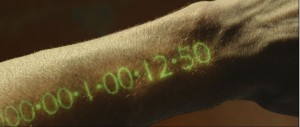Degeneracy Now! Suspended Between the Violence of Time and the Timelessness of Violence
Several uneventful Friday evenings ago, I stayed in with my best friend to watch In Time, starring Justin Timberlake and Amanda Seyfried. The film, written, produced, and directed by Andrew Niccol, takes place against the backdrop of a dystopian world in which the universal means of exchange is not money, but time.
Seyfried. The film, written, produced, and directed by Andrew Niccol, takes place against the backdrop of a dystopian world in which the universal means of exchange is not money, but time.
In the film, folks are born with a digital clock, bearing one year of time, on the forearm. And people stop aging at 25. It’s rather telling that even within the context of the film, youth as a signifier of vitality, bodily capacity, and endurance remains uncontested. But I digress. At age 25, the clock genetically encoded inside the body is activated. If one’s clock “times out,” or reaches zero, then one effectively dies. Within this temporo-economic paradigm, though, the life of an individual can be prolonged (without aging) through the procurement and stockpiling of time. Essentially, people, particularly poor people or the temporally disenfranchised if you will,spend vast amounts of their time working in exchange for time so that they can live longer, while the wealthy live forever. Evidently, longevity, or perhaps more pointedly, immortality, is commoditized as the object of value, aspiration, and dignity.

Watching the film from the vantage point of my own embodied experience as a young black man living with a degenerative disability was tremendously illuminating, notwithstanding glaring plot holes. The film pushed me to think about what might be at stake for folks “living in prognosis,” to invoke S. Lochlann Jain’s reformulation, when the body is understood and accorded with value as a measure of time in relation to the question of life. My essay thus serves as an introductory, tentative, and meditative engagement with the body, particularly the body inscribed in and modulated through debility, bodily pain, and decay — and its relationship to temporality. To be clear, I’m not particularly interested in examining the body as a measure of time within the biopolitical imaginary of the fictionalized world portrayed in the film; rather, I’m interested in thinking through the film as a point of reference in order to help me elaborate the ways in which the body as a measure of time augments the necropolitical conditions that render certain lives, particularly disabled/degenerative lives, an incomplete death — suspended between what I principally refer to here as the violence of time and the timelessness of violence.
Over time, the body has been congealed to time as a marker of modernity and coloniality. For example, productivity — historically propagated as a cornerstone of both economic and organizational competitiveness — necessitates that the body “maximize,” “properly utilize,” and “account for” the time it is accorded. Consequently, the productive subject is expected to “work around the clock” in order to get things done within a prescribed time frame. That bodies are inscribed in and modulated through this dialectic between productivity and temporality is an example of the violence of time.
 From the standpoint of degeneracy, the violence of time permeates my embodied existence in perhaps more insidious ways. Case in point: When I sleep at night, I am unable to physically roll my body from one side of the bed to the other without assistance. The attendant services program for students with physical disabilities at the university residence in which I live dispatches an attendant overnight so that students like me, students with limited mobility, can be “rolled.” Usually, I get rolled every two hours so as to prevent the formation of pressure sores on my body. However, there have been a few times when the attendant on duty, for whatever reason, missed some of my rolls during the night. It is precisely in these moments that I become conscious of my body as a measure of time. With every half hour that passes following the time at which I was meant to be rolled, the parts of my body sunken into the mattress begin to ache and the pain begins to slowly reverberate through my bones. Not only does this prevent me from falling asleep again, it also jolts me into a dreamlike state. As time lapses, I find myself hallucinating to the point where I falsely envision the attendant on duty serendipitously barging through my bedroom door, “saving” me from the perils of a body precariously congealed to temporality.
From the standpoint of degeneracy, the violence of time permeates my embodied existence in perhaps more insidious ways. Case in point: When I sleep at night, I am unable to physically roll my body from one side of the bed to the other without assistance. The attendant services program for students with physical disabilities at the university residence in which I live dispatches an attendant overnight so that students like me, students with limited mobility, can be “rolled.” Usually, I get rolled every two hours so as to prevent the formation of pressure sores on my body. However, there have been a few times when the attendant on duty, for whatever reason, missed some of my rolls during the night. It is precisely in these moments that I become conscious of my body as a measure of time. With every half hour that passes following the time at which I was meant to be rolled, the parts of my body sunken into the mattress begin to ache and the pain begins to slowly reverberate through my bones. Not only does this prevent me from falling asleep again, it also jolts me into a dreamlike state. As time lapses, I find myself hallucinating to the point where I falsely envision the attendant on duty serendipitously barging through my bedroom door, “saving” me from the perils of a body precariously congealed to temporality.
Fortunately (and the fact that I feel compelled to invoke the word “fortunately” speaks to the insidiousness of ableism as a relational formation), I’ve never been left to wait for more than four hours. It’s always been the case that just when my body feels as though it is about to implode from being stuck in one position, help arrives. I cannot even begin to imagine what young people with similar bodily experiences, but with far less access to support systems and whose bodies are even more precariously congealed to temporality than my own, must feel in such a situation. Specifically, I think about disabled youth throughout the Global South where degeneracy is not just inscribed on the body but also animated by the necropolitical conditions that render disabled life an incomplete death.
In many ways, disabled youth in Syria, in the Congo, Afghanistan, and Somalia live in a different time, as it were. Indeed, the links between debility, imperialism, military intervention, coloniality, and temporality in these parts of the world culminate in a force field of necropower whereby entire populations live waiting to be put to death. Not only does waiting (to be put to death) foreground the violence of time, it also excavates the timelessness of violence, that is, the ways in which brutality and monstrous neglect coalesce to bring into view ongoing and unfinished histories of trauma. Indeed, the screams of disabled youth have echoed through the hallways of society since time immemorial – a stain smudged all over the conscience of humanity.
Ironically, In Time doesn’t actually deal with the interplay between the violence of time and the timelessness of violence. Rather, the film’s response to the question of temporal injustice is problematically articulated by way of offering the democratization of time (longevity for everyone) as the answer. As far as I am concerned, “living in prognosis” does not mean disavowing the existential precariousness of degeneracy; rather, it means cultivating a deeply intimate and convivial relationship between the disintegration of my body and the violence of time. It means existing in the interpretative, as opposed to descriptive, dimensions of temporality; and thus illuminating the conditions that allow for a radical notion of livability.
film’s response to the question of temporal injustice is problematically articulated by way of offering the democratization of time (longevity for everyone) as the answer. As far as I am concerned, “living in prognosis” does not mean disavowing the existential precariousness of degeneracy; rather, it means cultivating a deeply intimate and convivial relationship between the disintegration of my body and the violence of time. It means existing in the interpretative, as opposed to descriptive, dimensions of temporality; and thus illuminating the conditions that allow for a radical notion of livability.
Indeed, to pair the words “degeneracy” and “now” together as a point of departure for thinking through the body as a measure of time is to reengage the question of life — for the degenerative body is problematically relegated either to the past (as a repository of biomedical failure in relation to the diagnosis / prognosis dialectic) or the future (as a measure of hopefulness in relation to the desire for longevity). Seldom are the contours of degeneracy discursively traversed along the spatiotemporal dimensions of the present, the now, as it were. From this point of view, what degeneracy signifies is existential defiance, an expanded notion of untimeliness.




0 comments